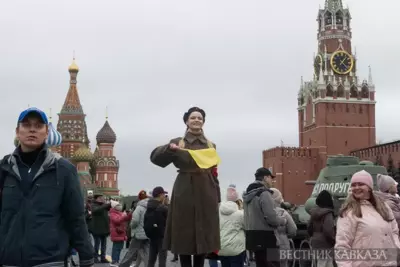In recent days, the mass protest movement against the increase in electricity tariffs, which has been led by the civil initiative 'No to Robbery!', has been experiencing a sharp slowdown. If the protests previously gathered about 10-12 thousand people, now there are just about 100-200 protesters on Baghramian Avenue. The initiative 'No to Robbery!' has been carrying out a protest in the center of Yerevan for two weeks now, participants have been demanding the cancellation of the decision of the Commission for regulation of public services of 17 June on increasing electricity tariffs, and revising tariffs imposed last year, with a view to reducing them, and punishing the police officers who used force against demonstrators and journalists on June 23.
The movement began to fade after 28 June, when the former head of the initiative, Vaginak Shushanyan, urged protesters to leave the avenue and go to Freedom Square, where the initiative proposed discussing further steps. Shushanyan said this decision by the leaders of the movement was because the protesters had not received a response to their demands, ‘’Is it appropriate and safe to stay on Baghramyan Avenue? I propose moving on to other means of disobedience and exerting pressure on the government. Have we achieved the desired result, each time being beaten by the police?"
This behavior of the leaders of the initiative, who had called people to fight to the end before, led to the rejection by the overwhelming majority of the participants. Under whistling and chanting of "Shame!" the initiative members were forced to leave the Avenue. A small group of their supporters left along with them, but the vast majority, more radical, remained standing on the Avenue.
Very quickly, an initiative group was formed of participants, who undertook the coordination of the actions of the protesters. However, until now, no one knew the names of these young people.
In any case, the events of June 28 marked the failure of the initiative "No to Robbery!", evidence of which was the transformation of the mass protest movement, or elektroErevana picket, to a small group of people, whose number is decreasing day by day.
What are the reasons for what happened?
Firstly, the lack of experience of the leaders of the initiative in coordinating the crowd in general, not to mention such a large number of people. One of the clearest manifestations of theor complete amateurism was the fact that the initiative, which conceived mass actions, did not have speakers, so they needed to find them in a hurry. This inexperience predetermined the high level of spontaneity and lack of organization of elektroYerevana, a manifestation of which became meaningless rallies of the initiative (its leaders had virtually nothing to say to the people), and a number of ill-simple circuits. When the President invited the leaders of the 'No to Robbery!' initiative to talk, the latter, without a known plan how to behave, had to organize an urgent meeting on Baghramian Avenue before giving an answer.
The second reason is the expression of the defeatist position on the part of the initiative "No to Robbery!" In the understanding of most of the protesters, the concept of "stay to the end’’, voiced by the leaders of the movement, meant not being afraid of being beaten by the police.
Thirdly, the Armenian opposition does not consider Serzh Sargsyan to be the legitimate president, the leader to whom they would address for a decision of these or other issues. Therefore, over the last 6-7 years the opposition has not been leading people to Baghramyan Avenue to the presidential palace. An exception in this regard were the events of two years ago, when the leader of the small opposition party 'Heritage', the ex-presidential candidate Raffi Hovannisian, led his supporters to the Avenue to protest against the presidential election results.
Fourthly, the leaders of the movement were isolated from politics. The leaders of the initiative say they do not belong to any party, and the movement is not of a political nature. Meanwhile, according to political scientist Armen Badalyan, social meetings in themselves are political. Moreover, in this case the demonstrations are directed against government policies in the energy sector. According to the analyst, not 10-12 thousand but 200 thousand signatories were needed to address this issue.
The expert Arman Gevorgyan believes that the pursuit of activists to be isolated from the political powers demonstrates their limitations: "The activists have overestimated their abilities, because they do not understand the role of political parties. They did not understand that in the case of cooperation with the opposition, the movement could become more thoughtful and ambitious. But they did not want to deal with the parties. Instead, they tried to play the role of leader of the new wave, the new generation, of which much is written today in the media. However, in order to become leaders of the new wave, it is necessary to prepare for this seriously."
In contrast to the initiative 'No to Robbery!', another civil initiative 'I Am Against', which has opposed the introduction of funded pensions, thanks to the cooperation with the opposition, was able to achieve a certain result. Opposition parties have prepared a lawsuit in the competent Constitutional Court (CC). Another issue is the turn of the decision subsequently taken. The government was forced to re-discuss the issue of funded pensions. Moreover, under pressure from the powerful protest movement, and as a result of decisions of the COP, the government of Tigran Sargsyan was forced to resign. (the Constitutional Court decision of April 2, 2014 excludes any limitation of citizens' rights, including the right to property. The paper pointed to the need for revision of the law on the responsibility of the government structures and clarify the obligations of pension funds).
Returning to the question of the relationship between the initiative and the parties, we note that the opposition does not impose its cooperation and a number of its representatives took part in actions, not as politicians, but as ordinary citizens. Some opposition members were also in a 'living wall' between protesters and police. Then the representatives of the initiative made a series of blunders, trying to maintain the momentum of the struggle and give it a fresh breath. A new initiative group coordinating the actions of the protesters was created. The function of the group is to maintain public order, explaining to citizens the economic and legal problems. Civil society activists Arutyun Arutyunyan and Ayk Parikyan announced a hunger strike from June 30 in Baghramyan Avenue. They're sure that there is not enough to hold a sedentary picket to express protest. Many media are involved in the resuscitation of electroYerevan.
However, due to mistakes made, it is unlikely to revive the protest wave. Neither rock music nor the music of Strauss that are heard today on Baghramyan Avenue will help revive the almost-finished electroYerevan.






